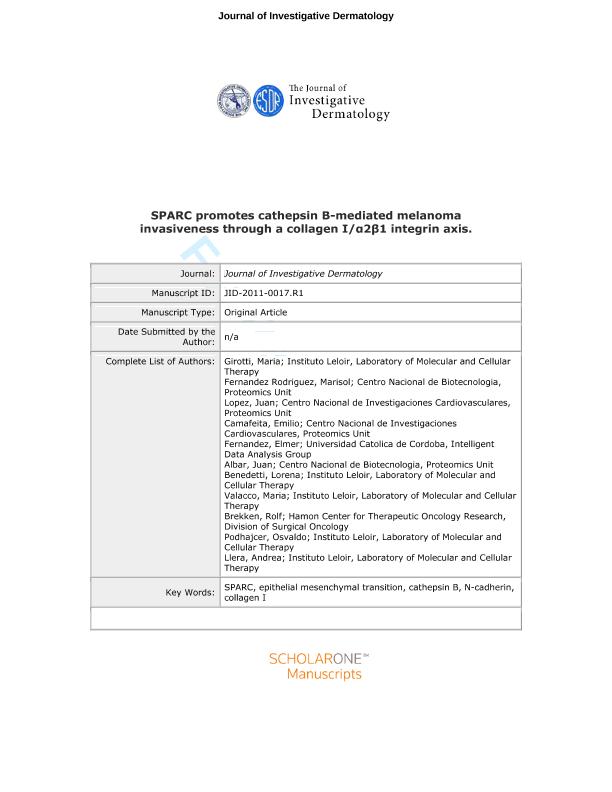Artículo
SPARC promotes cathepsin B-mediated melanoma invasiveness through a collagen i/α2Β1 integrin axis
Girotti, Maria Romina ; Fernández, Marisol; López, Juan A.; Camafeita, Emilio; Fernandez, Elmer Andres
; Fernández, Marisol; López, Juan A.; Camafeita, Emilio; Fernandez, Elmer Andres ; Albar, Juan P.; Benedetti, Lorena Gabriela
; Albar, Juan P.; Benedetti, Lorena Gabriela ; Valacco, Maria Pia
; Valacco, Maria Pia ; Brekken, Rolf A.; Podhajcer, Osvaldo Luis
; Brekken, Rolf A.; Podhajcer, Osvaldo Luis ; Llera, Andrea Sabina
; Llera, Andrea Sabina
 ; Fernández, Marisol; López, Juan A.; Camafeita, Emilio; Fernandez, Elmer Andres
; Fernández, Marisol; López, Juan A.; Camafeita, Emilio; Fernandez, Elmer Andres ; Albar, Juan P.; Benedetti, Lorena Gabriela
; Albar, Juan P.; Benedetti, Lorena Gabriela ; Valacco, Maria Pia
; Valacco, Maria Pia ; Brekken, Rolf A.; Podhajcer, Osvaldo Luis
; Brekken, Rolf A.; Podhajcer, Osvaldo Luis ; Llera, Andrea Sabina
; Llera, Andrea Sabina
Fecha de publicación:
08/2011
Editorial:
Nature Publishing Group
Revista:
Journal Of Investigative Dermatology Symposium Proceedings
ISSN:
1087-0024
e-ISSN:
1529-1774
Idioma:
Inglés
Tipo de recurso:
Artículo publicado
Clasificación temática:
Resumen
In melanoma, the extracellular protein SPARC (secreted protein acidic and rich in cysteine) is related to tumor progression. Some of the evidence that links SPARC to melanoma progression indicates that SPARC may be involved in the acquisition of mesenchymal traits that favor metastatic dissemination. However, no molecular pathways that link extracellular SPARC to a mesenchymal phenotype have been described. In this study, global protein expression analysis of the melanoma secretome following enforced downregulation of SPARC expression led us to elucidate a new molecular mechanism by which SPARC promotes cathepsin B-mediated melanoma invasiveness using collagen I and α2β1 integrins as mediators. Interestingly, we also found that the transforming growth factor (TGF)-β1 contribution to cathepsin B-mediated invasion is highly SPARC dependent. In addition, induction of the E-cadherin to N-cadherin switch by SPARC enabled melanoma cells to transmigrate across an endothelial layer through a mechanism independent to that of enhancing invasion. Finally, SPARC also enhanced the extracellular expression of other proteins involved in epithelial–mesenchymal transformation, such as family with sequence similarity 3, member C/interleukin-like EMT-inducer. Our findings demonstrate a previously unreported molecular pathway for SPARC activity on invasion and support an active role of SPARC in the mesenchymal transformation that contributes to melanoma dissemination.
Archivos asociados
Licencia
Identificadores
Colecciones
Articulos(CCT - CORDOBA)
Articulos de CTRO.CIENTIFICO TECNOL.CONICET - CORDOBA
Articulos de CTRO.CIENTIFICO TECNOL.CONICET - CORDOBA
Citación
Girotti, Maria Romina; Fernández, Marisol; López, Juan A.; Camafeita, Emilio; Fernandez, Elmer Andres; et al.; SPARC promotes cathepsin B-mediated melanoma invasiveness through a collagen i/α2Β1 integrin axis; Nature Publishing Group; Journal Of Investigative Dermatology Symposium Proceedings; 131; 8-2011; 2438-2447
Compartir
Altmétricas



